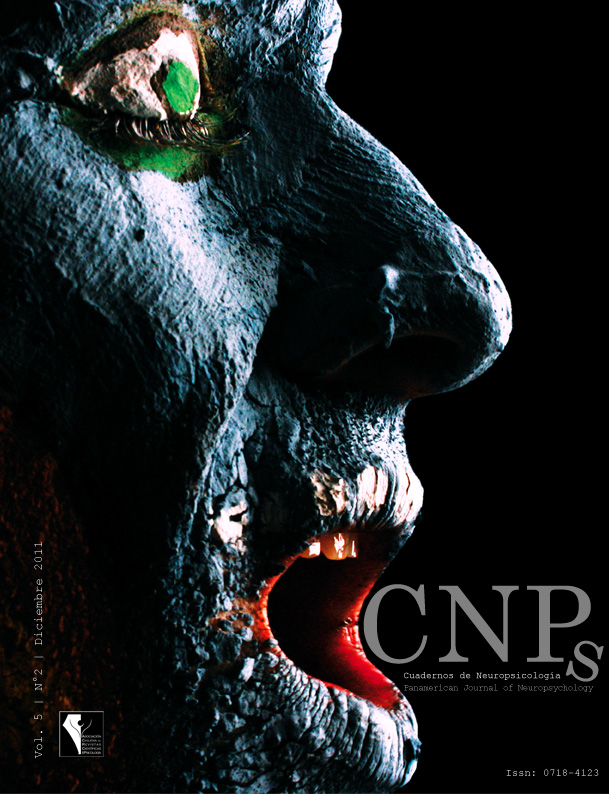Efecto Stroop y sus limitaciones ejecutivas en la práctica neuropsicológica infantil. Stroop effect and its limitations in practice executive neuropsychological child.
Abstract
Resumen
Introducción: La prueba de Stroop modalidad palabra / color computarizada es de limitada aplicación en la población clÃnica infantil. Una adaptación digital de la prueba exige la rápida respuesta del infante y a la vez que los procesos utilizados en la prueba tenga una interferencia en el niño. Si el niño no se adapta a las exigencias digitales no ocurre la interferencia entre los procesos y la prueba no tiene efecto. Material y Método: La investigación pretende determinar si los resultados de la prueba Stroop, modalidad palabra / color, se relacionan con los resultados de otras pruebas que evalúan las funciones ejecutivas. El Dpto. de NeuropsicologÃa propuso revisar todos los resultados de la prueba SESH en la población atendida en el centro de 7 a 15 años del 2009 – 2011. Las pruebas analizadas fueron: Stroop, Wisconsin, Tiempo de reacción compleja y la Atención sostenida simple. Resultado: Las historias clÃnicas demostraron que de los 207 niños evaluados 59 presentan puntuaciones por encima de la norma superior en el Stroop. Sin embargo, los resultados en el Wisconsin, el tiempo de reacción y la atención reporta que los 59 niños tienen un Ãndice patológico. La investigación muestra que las puntuaciones elevadas en el Stroop no es signo de buen desempeño en las otras pruebas. Conclusiones: La tarea Stroop no es efectiva en todos los niños analizados. Los problemas en la velocidad de procesamiento y atencionales es una condición negativa para ejecutar con éxito la tarea computarizada Stroop modalidad palabra / color en la población infantil.
Palabras claves: Stroop; neuropsicologÃa infantil; lectura; evaluación psicológica.
Abstract
Introduction: The test of Stroop on line modality word / color is of limited application in the clinical child population. A digital adaptation of the test demands the infant's quick answer and at the same time that the processes used in the test have an interference in the boy. If the boy doesn't adapt to the digital demands it doesn't happen the interference between the processes and the test he doesn't have effect. Material and Method: The investigation seeks to determine if the results of the test Stroop, modality word / color, they are related with the results of other tests that evaluate the executive functions. The Dpto. of Neuropsychology he intended to revise all the results of the test SESH in the population from 7 to 15 years of the 2009 - 2011. The analyzed tests were:
Stroop, Wisconsin, Time of complex reaction and the simple sustained Attention. Result: The clinical histories demonstrated that of the 207 evaluated children 59 present punctuations above the superior norm in the Stroop. However, the results in the Wisconsin, the time of reaction and the attention reports that the 59 children have a pathological index. The investigation shows that the punctuations risen in the Stroop are not sign of good acting in the other tests. Conclusions: The task Stroop is not effective in all the analyzed children. The problems in the prosecution speed and atencionales are a negative condition to execute with success the on-line task Stroop modality word / color in the infantile population.
Key words: Stroop, Child neuropsychological, reading, psychological evaluation.
Downloads
Published
How to Cite
Issue
Section
License
Articles published in this journal are protected under the Creative Commons Attribution-NonCommercial-ShareAlike 4.0 International (CC BY-NC-SA 4.0) license. This means that authors retain full rights over their research and publications at all times. As a journal, we fully respect and promote the principles of open access established by this license, allowing the work to be shared, adapted, and distributed for non-commercial purposes, provided that appropriate credit is given to the authors and any derivative works are licensed under the same terms.
Authors are responsible for obtaining the required permission when they wish to reproduce part of the material (figures, etc.) from other publications.
Likewise, CNPs allows authors to host in their personal sites or other repositories that they deem convenient the Final and Definitive Version of the published article with the format assigned by the journal. In no case do we allow access to preprints of the article under evaluation or already published.
When submitting an article to CNPs you are aware that all the contents of CNPs are under a Creative Commons License. In which it is allowed to copy and share the contents freely, always making reference to the origin of the publication and its author.





